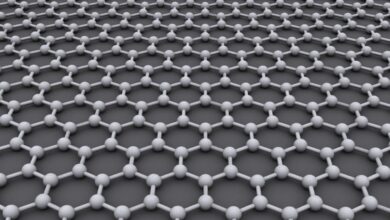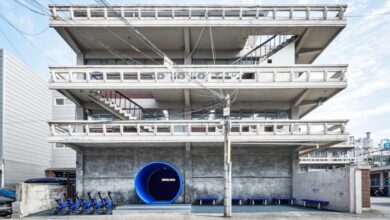
Graphene, called the material of dreams, has been in the spotlight as the next-generation material since its discovery in 2004.
Graphene can be considered a single layer of graphite. In 2004, a research team from the University of Manchester in the UK managed to separate the thinnest layer of graphite by repeatedly sticking and peeling Scotch tape on a pencil lead, leading to the first discovery of graphene. Graphene is structured where carbon atoms come together in a two-dimensional plane, making it one of the allotropes of carbon. The crystalline structure of graphene is such that a hexagonal shape is formed, extending in two dimensions, with three bonds at each vertex of the structure. This stable molecular structure is why it is called the thinnest material in the world.
With a thickness of just 0.2nm, equivalent to two ten-billionths of a meter, the strength of this single layer of carbon is beyond imagination. It conducts electricity over 100 times better than copper and can move electrons more than 100 times faster than single-crystal silicon, a semiconductor. It is also more than 200 times stronger than steel and has over twice the thermal conductivity of diamond. Its elasticity allows it to retain its electrical properties even when stretched or bent, and its durability, coupled with being a single layer, means it absorbs less visible light and can be applied transparently.
Due to these features, graphene is considered a leading material for the future, garnering attention for its use in various industries, including fashion, displays, secondary batteries, solar cells, airplanes, automobiles, lighting, and more.

What about Graphene Fibers?
Graphene fibers, when used in textiles, prevent the attachment of micro-substances or bacteria on the fabric surface, and any adhered contaminants can be easily removed through washing. Their 89.3% far-infrared radiation ability penetrates 80 times deeper than normal heat, invigorating cell tissues.
Especially, graphene fibers are environmentally friendly materials, and the graphene composite process does not involve any separate chemical treatment, hence not emitting any harmful environmental substances. They are considered eco-friendly fibers by the fashion industry as well, leading the way in environmental protection and contributing to saving the planet.
Items utilizing graphene fibers include outdoor wear, innerwear, bedding, lining, fillers, and water sports wear, and are being used in various fields, each with different characteristics.
For outdoor wear, graphene offers anti-static properties, moisture-wicking and quick-drying features, antibacterial qualities, and bulkiness. Another reason why graphene is gaining attention is its sustainability.
Fiber materials can be produced sustainably, extracted from recycled plastics, utilizing graphene's inherent functionalities while being environmentally friendly and ethical in the production process.
An industry insider said, "Carbon is actually the most widely distributed material on Earth, found in everything from coal to diamonds, and even in soil and organic matter in our bodies." They added, "The value of such common carbon is on the rise, and carbon fiber, utilizing carbon, is being used in the majority of industrial materials and products. A notable example is its use in the manufacturing of futuristic cars and spacecraft exteriors and frames, being stronger than steel yet lighter in weight and with excellent chemical resistance."
| Graphene Applied Items | Functions |
| Outdoor Wear | Anti-static, Moisture-wicking, Durability, Warmth, Far-Infrared, UV Protection, Lightweight |
| Innerwear | Anti-static, Moisture-wicking, Durability, Warmth, Far-Infrared, UV Protection, Lightweight |
| Bedding | Anti-static, Moisture-wicking, Durability, Warmth, Far-Infrared |
| Lining | Anti-static, Antibacterial, Far-Infrared, UV Protection, Lightweight, Resilience |
| Fillers | Anti-static, Warmth, Far-Infrared, Resilience, Bulkiness, Lightweight |
| Water Sports | Moisture-wicking, Far-Infrared, UV Protection, Resilience |
Current Technology in Graphene Fibers?...Neo Enpra Leading the Way
The company leading the technology in graphene fibers is currently Neo Enpra (CEO Heonsang Kim).
Graphene fibers available in the market are mostly released as coatings on yarn or fabric. However, Neo Enpra is pioneering in the development of yarn based on graphene's original technology.
Neo Enpra is a specialized high-tech new material company focused on graphene, leading the mass synthesis of high-purity graphene and the mass production of graphene fibers. It currently supplies graphene fibers through companies like Huvis, Ilsin Textile, and Hyosung.
A product that has recently gained attention is the one developed by DuPont, which synthesizes graphene with Sorona, a corn fiber. This product has been gathering interest from the related industries since its first reveal at Preview in Seoul last August.
Sorona, already popular as an eco-friendly fiber, is now gaining attention as a next-generation fiber with the integration of graphene's properties.

Graphene, with its excellent electron mobility and electrical conductivity, is a futuristic new material that can be applied across various fields including electricity, electronics, semiconductors, defense, and even roads. Neo Enpra has acquired the Global Recycling Standard certification by compounding graphene with recycled PET.
As a result, the outdoor industry is recently expanding its adoption of graphene materials.Neo Enpra's graphene materials are being supplied to major sports brands such as National Geographic, NEPA, Wide Angle, and Dynafit, thus expanding the market size. Additionally, the company is broadening its reach by applying graphene materials across various industries, including cosmetics, household goods, appliances, medical devices, and beauty equipment.Heonsang Kim, CEO of Neo Enpra, mentioned, "Starting with the functional fabric exhibition in Portland, USA, in April, and moving on to Techtextil in Germany in June, and our first domestic exhibition in August, we are intensifying the promotion of graphene fibers. Neo Enpra plans to further develop graphene new materials that can be applied across various industrial fields."According to a market research institute, the global eco-friendly fiber market is expected to grow at an average annual rate of 10%, reaching approximately $70 billion (about 83 trillion KRW) by 2025, making it a high-potential market. Neo Enpra plans to develop and release various eco-friendly fibers using graphene, known as the material of dreams.Neo Enpra is a specialist in advanced new materials focused on graphene. The company strengthened its promotion of graphene fibers by participating in the Preview in Seoul exhibition held last August.Kim said, "Aligning with global trends, we are accelerating the development of yarns that apply graphene, an advanced material, to various eco-friendly materials. One of them is a product that applies graphene to DuPont's corn fiber, Sorona, which attracted much attention from domestic and international buyers during the exhibition."He explained, "Graphene + Sorona can implement functions without separate processing by fusing graphene with polyester. This minimizes carbon emissions and harmful substances from post-processing, making it environmentally friendly."Neo Enpra's main product line includes 'Graphene Polyester', 'Graphene Poly-Cotton Blend Yarn', 'Graphene Poly Staple Fiber', and 'Graphene Nylon'. A variety of eco-friendly and high-functionality fibers using graphene are set to be released, with mass production based on original technology.CEO Kim shared, "Graphene is a material consisting of carbon atoms isolated physically or chemically from multi-layered graphite structures, known as a 'dream material' with various functionalities. Its primary functionalities include exceptional durability, far-infrared radiation, UV protection, and anti-static properties."For graphene-infused yarns, traditionally, due to the size and quality of graphene particles, they are not suitable for application to the yarn itself and are mostly produced through coating. This results in a dark black color of the yarn, making it difficult to produce in various colors.However, Neo Enpra's Graphinus yarn, with high-quality graphene melted into the material (polymer), facilitates the implementation of colors for clothing. This is the major difference between Neo Enpra's graphene fibers and those available in the market.CEO Kim stated, "Usually, additional chemical processing is done to create functional fibers. However, with Neo Enpra's products, the functionality of graphene is expressed in the state of yarn/fabric, minimizing the need for chemical processing and additional steps, allowing for more eco-friendly products."*** TAG 0 ***#Graphene #Graphene Fiber #Dream Fiber #Neo Enpra #Eco-Friendly Fiber
Read more this category
 1. Hot Summer, Hot Body 'Soyou' Photoshoot
1. Hot Summer, Hot Body 'Soyou' Photoshoot 2. Generation Z has also fallen for the charm of 'RAdog'
2. Generation Z has also fallen for the charm of 'RAdog' 3. Creating the 'Next Commerce Ecosystem' with ABLY
3. Creating the 'Next Commerce Ecosystem' with ABLY 4. Do you know about the dream material 'Graphene'?
4. Do you know about the dream material 'Graphene'? 5. The fashion industry is poised to expand its territory with the launch of licensed brands.
5. The fashion industry is poised to expand its territory with the launch of licensed brands. 6. Expanding the Market Pie: 'Frontier' Companies
6. Expanding the Market Pie: 'Frontier' Companies 7. Fall-Winter 2021 Men's Fashion Trend: 'Workleisure'
7. Fall-Winter 2021 Men's Fashion Trend: 'Workleisure'
